跨文化商务交际U1(1)
- 格式:ppt
- 大小:4.46 MB
- 文档页数:58

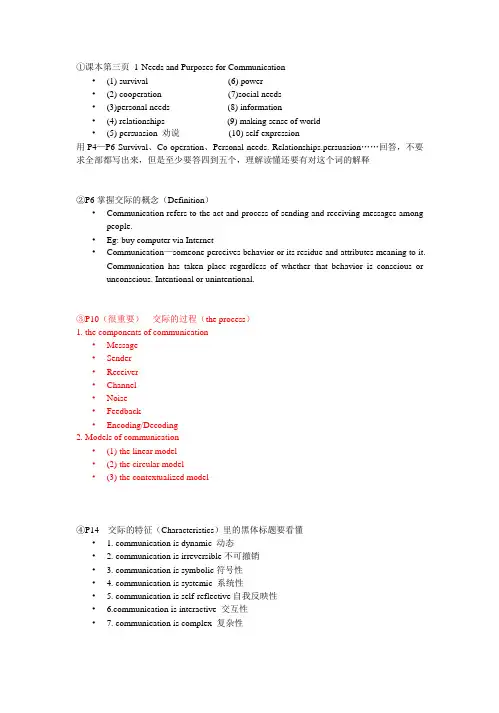
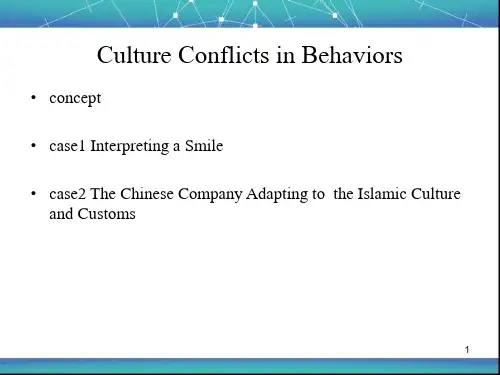



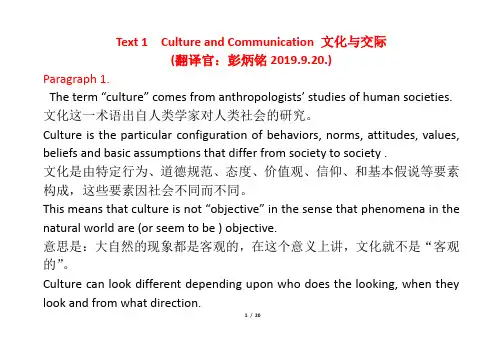
Text 1 Culture and Communication 文化与交际(翻译官:彭炳铭2019.9.20.)Paragraph 1.The term “culture” comes from anthropologists’ studies of human societies. 文化这一术语出自人类学家对人类社会的研究。
Culture is the particular configuration of behaviors, norms, attitudes, values, beliefs and basic assumptions that differ from society to society .文化是由特定行为、道德规范、态度、价值观、信仰、和基本假说等要素构成,这些要素因社会不同而不同。
This means that culture is not “objective” in the sense that phenomena in the natural world are (or seem to be ) objective.意思是:大自然的现象都是客观的,在这个意义上讲,文化就不是“客观的”。
Culture can look different depending upon who does the looking, when they look and from what direction.1/ 20文化看起来是不同的,这有赖于谁在看、何时看、从什么方向(角度)来看。
This makes culture difficult to grasp. 这就使得文化很难掌握。
Paragraph 2.Culture has been defined in many ways but a classic definition is : 文化的定义是多方面的,但有一个经典的定义是:Culture consists of patterns, explicit and implicit, of and for behavior, acquired and transmitted by symbols, constituting the distinctive achievements of human groups … the essential core of culture consists of traditional ideas and especially their attached values.”【译文】文化包含各种外显和内隐的行为模式,这些行为模式通过符号习得和传播,构成了人类群体与众不同的成就。
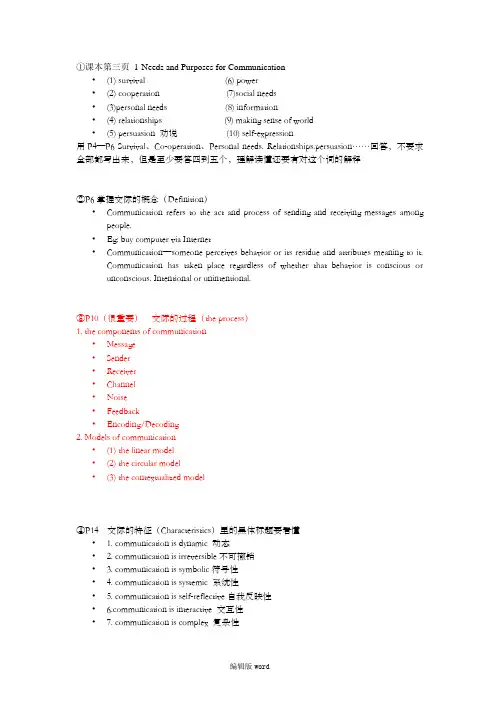
①课本第三页1-Needs and Purposes for Communication•(1) survival (6) power•(2) cooperation (7)social needs•(3)personal needs (8) information•(4) relationships (9) making sense of world•(5) persuasion 劝说(10) self-expression用P4—P6 Survival、Co-operation、Personal needs. Relationships.persuasion……回答,不要求全部都写出来,但是至少要答四到五个,理解读懂还要有对这个词的解释②P6掌握交际的概念(Definition)•Communication refers to the act and process of sending and receiving messages among people.•Eg: buy computer via Internet•Communication—someone perceives behavior or its residue and attributes meaning to it.Communication has taken place regardless of whether that behavior is conscious or unconscious. Intentional or unintentional.③P10(很重要)交际的过程(the process)1. the components of communication•Message•Sender•Receiver•Channel•Noise•Feedback•Encoding/Decoding2. Models of communication•(1) the linear model•(2) the circular model•(3) the contextualized model④P14 交际的特征(Characteristics)里的黑体标题要看懂• 1. communication is dynamic 动态• 2. communication is irreversible不可撤销• 3. communication is symbolic符号性• 4. communication is systemic 系统性• 5. communication is self-reflective自我反映性• munication is interactive 交互性•7. communication is complex 复杂性⑤P22里的最后一段中影响跨文化交际的主要三个因素Language barriers,different values,different cultural patterns of behavior⑥ICC与ICBC的概念1. intercultural communication (ICC)•--interpersonal communication between members of different cultures.2. intercultural business communication (ICBC)•--communication within and between businesses that involve people from more than one culture⑦P31课后练习中的Discussion Questions的前三个问题⑧P41 关于文化的概念在这页的第五段•Culture is the total accumulation(积累)of beliefs, customs, values, behaviors, institutions (习俗)and communication patterns(样式)that are shared, learned and passed down through the generations in an identifiable group of people.⑨P42 文化的特点还要解释四个到五个• 1. culture is not innate; it is learned (e.g. sneezing)• 2. culture is transmitted from generation to generation• 3. culture is selective• 4. the facets of culture are interrelated (e.g. women’s movement)• 5. culture is ethnocentric• 6. culture is subject to change⑩P46价值观的概念(definition of value)•One’s principles or standards, one’s judgment of what is valuable or important in life • A broad tendency to prefer certain states of affairs over others. (Hofstede P46)• A conception, explicit or implicit, distinctive of an individual or characteristic of a group, of the desirable which influences the selection from available modes, means, and ends of action.⑾P45(重点)values from the core of culture• 1.values form the core of culture• 2. values are the deepest manifestations of culture and most difficult to understand by an outsider. (symbols-heroes-rituals-values, by Hofstede)⑿P48 价值观的分类• 1.universal values (e.g., happy life)• 2.cultural-specific values (e.g.. modesty for Chinese culture)• 3. peculiar expression or deviations of individuals within cultures (subjective culture)⒀P49 价值观是怎样形成的?how to get one’s value?• 1. from one’s family• 2.from school education teachers• 3. from one’s peers• 4. from society at large⒁P59(很重要)hofstede-Bond's Value Dimensions•Individualism vs. Collectivism (P.61)•Power Distance•Uncertainty Avoidance•Masculinity vs. Femininity回答这个题目时要说这个理论是谁写的,叫什么名字,理论是什么(从P60-64四个角度回答)还要解释,还要给例子,比如P62的图表。
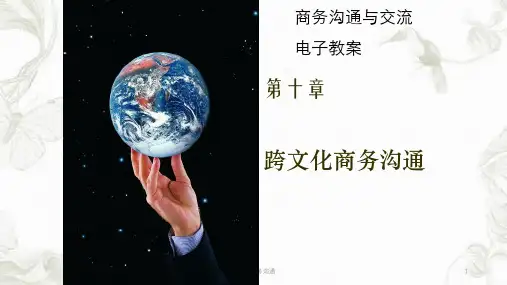
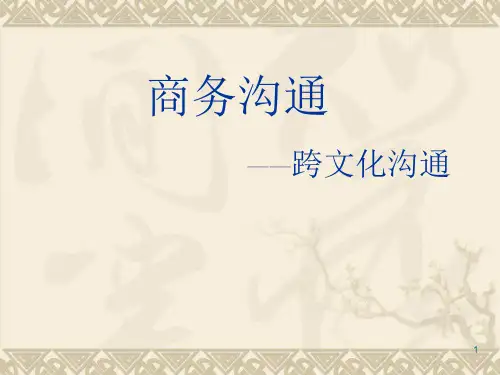
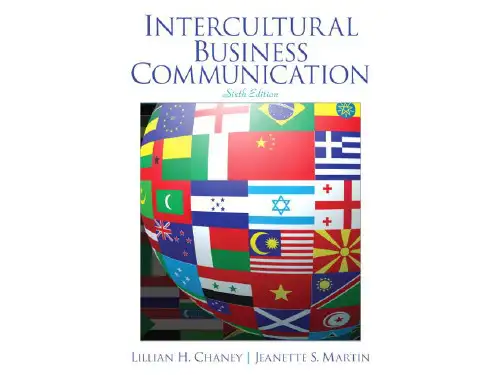
①课本第三页1-Needs and Purposes for Communication•(1) survival (6) power•(2) cooperation (7)social needs•(3)personal needs (8) information•(4) relationships (9) making sense of world•(5) persuasion 劝说(10) self-expression用P4—P6 Survival、Co-operation、Personal needs. Relationships.persuasion……回答,不要求全部都写出来,但是至少要答四到五个,理解读懂还要有对这个词的解释②P6掌握交际的概念(Definition)•Communication refers to the act and process of sending and receiving messages among people.•Eg: buy computer via Internet•Communication—someone perceives behavior or its residue and attributes meaning to it.Communication has taken place regardless of whether that behavior is conscious or unconscious. Intentional or unintentional.③P10(很重要)交际的过程(the process)1. the components of communication•Message•Sender•Receiver•Channel•Noise•Feedback•Encoding/Decoding2. Models of communication•(1) the linear model•(2) the circular model•(3) the contextualized model④P14 交际的特征(Characteristics)里的黑体标题要看懂• 1. communication is dynamic 动态• 2. communication is irreversible不可撤销• 3. communication is symbolic符号性• 4. communication is systemic 系统性• 5. communication is self-reflective自我反映性• munication is interactive 交互性•7. communication is complex 复杂性⑤P22里的最后一段中影响跨文化交际的主要三个因素Language barriers,different values,different cultural patterns of behavior⑥ICC与ICBC的概念1. intercultural communication (ICC)•--interpersonal communication between members of different cultures.2. intercultural business communication (ICBC)•--communication within and between businesses that involve people from more than one culture⑦P31课后练习中的Discussion Questions的前三个问题⑧P41 关于文化的概念在这页的第五段•Culture is the total accumulation(积累)of beliefs, customs, values, behaviors, institutions (习俗)and communication patterns(样式)that are shared, learned and passed down through the generations in an identifiable group of people.⑨P42 文化的特点还要解释四个到五个• 1. culture is not innate; it is learned (e.g. sneezing)• 2. culture is transmitted from generation to generation• 3. culture is selective• 4. the facets of culture are interrelated (e.g. women’s movement)• 5. culture is ethnocentric• 6. culture is subject to change⑩P46价值观的概念(definition of value)•One’s principles or standards, one’s judgment of what is valuable or important in life • A broad tendency to prefer certain states of affairs over others. (Hofstede P46)• A conception, explicit or implicit, distinctive of an individual or characteristic of a group, of the desirable which influences the selection from available modes, means, and ends of action.⑾P45(重点)values from the core of culture• 1.values form the core of culture• 2. values are the deepest manifestations of culture and most difficult to understand by an outsider. (symbols-heroes-rituals-values, by Hofstede)⑿P48 价值观的分类• 1.universal values (e.g., happy life)• 2.cultural-specific values (e.g.. modesty for Chinese culture)• 3. peculiar expression or deviations of individuals within cultures (subjective culture)⒀P49 价值观是怎样形成的?how to get one’s value?• 1. from one’s family• 2.from school education teachers• 3. from one’s peers• 4. from society at large⒁P59(很重要)hofstede-Bond's Value Dimensions•Individualism vs. Collectivism (P.61)•Power Distance•Uncertainty Avoidance•Masculinity vs. Femininity回答这个题目时要说这个理论是谁写的,叫什么名字,理论是什么(从P60-64四个角度回答)还要解释,还要给例子,比如P62的图表。
跨⽂化商务英语交际跨⽂化商务英语交际Unit 1 introductions“Humans are social animals. To find an individual choosing to live alone in the world is so rare as to confirm that human beings need to live amongst each other and group together.”“Networking begins with introducing yourselves.”“You never have a second chance to make a good first impression.”Reading aloud practiceNo one lives alone in this world. Few people can go without friends. In order to survive or succeed in the working world, we need to group together and form our network of friends and contacts. To get to know people, we always begin by introducing ourselves to each other. Therefore, introductions are important. A good introduction is a good announcement to make others know you well and a proper introduction will give others a good first impression. Studies show that people form their first impression of you within the first few seconds of the meeting –when you are introducing yourselves. Once the first impression is made, it is difficult to change. That’s w hy people say that you never have a second chance to make a first impression. Business cardIt’s a common business practice to exchange business cards with people we meet. It is even considered rude by many when a card is not offered. The business card is a great way for people to remember you as well as tohave contact information especially telephone number and e-mail. On a business card you should include your full name, complete address, affiliation, telephone, fax and e-mail information. Some people also include some information about themselves such as a professional designation or education background. Finally, a corporate logo or symbol can add some color to a card.Information on a business cardBusiness termsconsulting groupaccountantGmbhproduct managerS.A.senior managerconsulting group:also called a consulting firm or company, is a business organization that offersspecialist and professional knowledge or advice onbusiness affairs to companies.consult, consultant, consultancyaccountant:a professional who examines thefinancial accounts of businesses or people account, accountingGmbh:German abbreviation for “company limited ”product manager:a manager whose job is to supervisethe company’s productTalk about yourself.Now look around you. Find someone you do not know and introduce yourself to him/her.Hello. My name’s Helen. I’m from Hong Kong.Hello. My name’s Alice. I’m from Macao. Nice to m eet you, Helen. Nice to meet you, Alice. How are you doing here? Oh, everything is fine with me. Thank you.How about you?I’m fine, too. Thanks.。